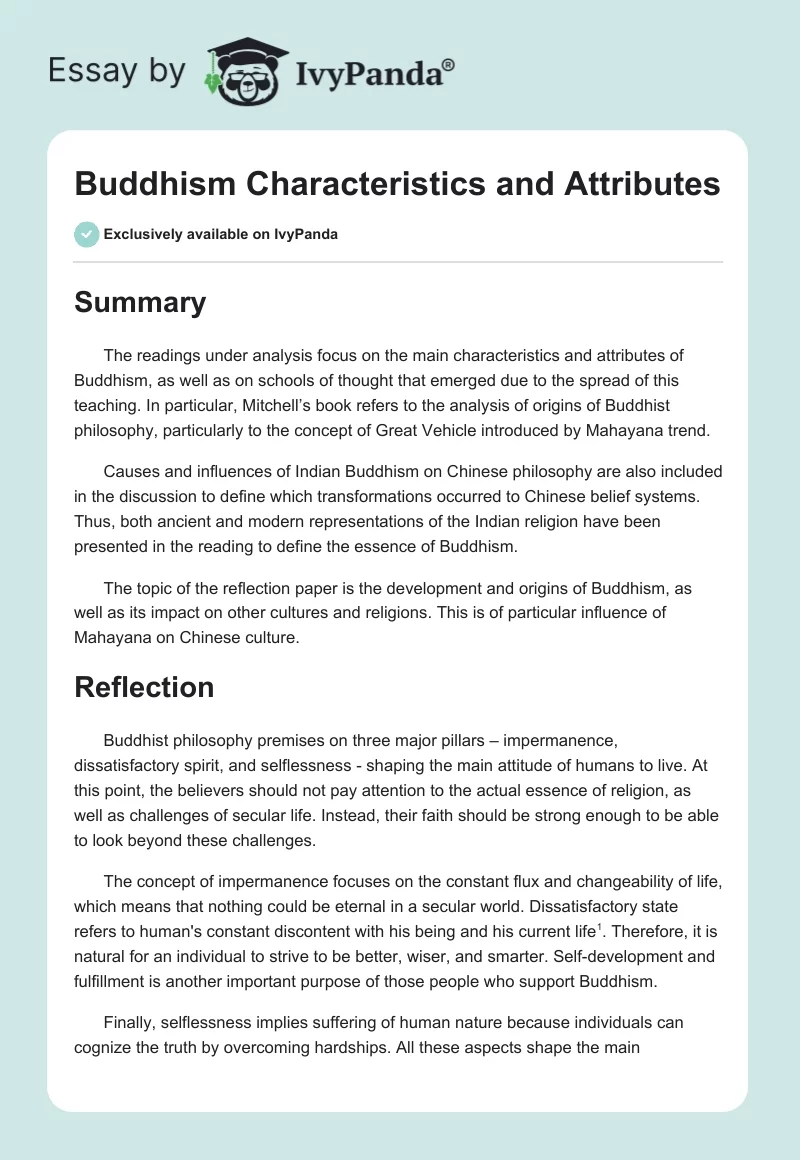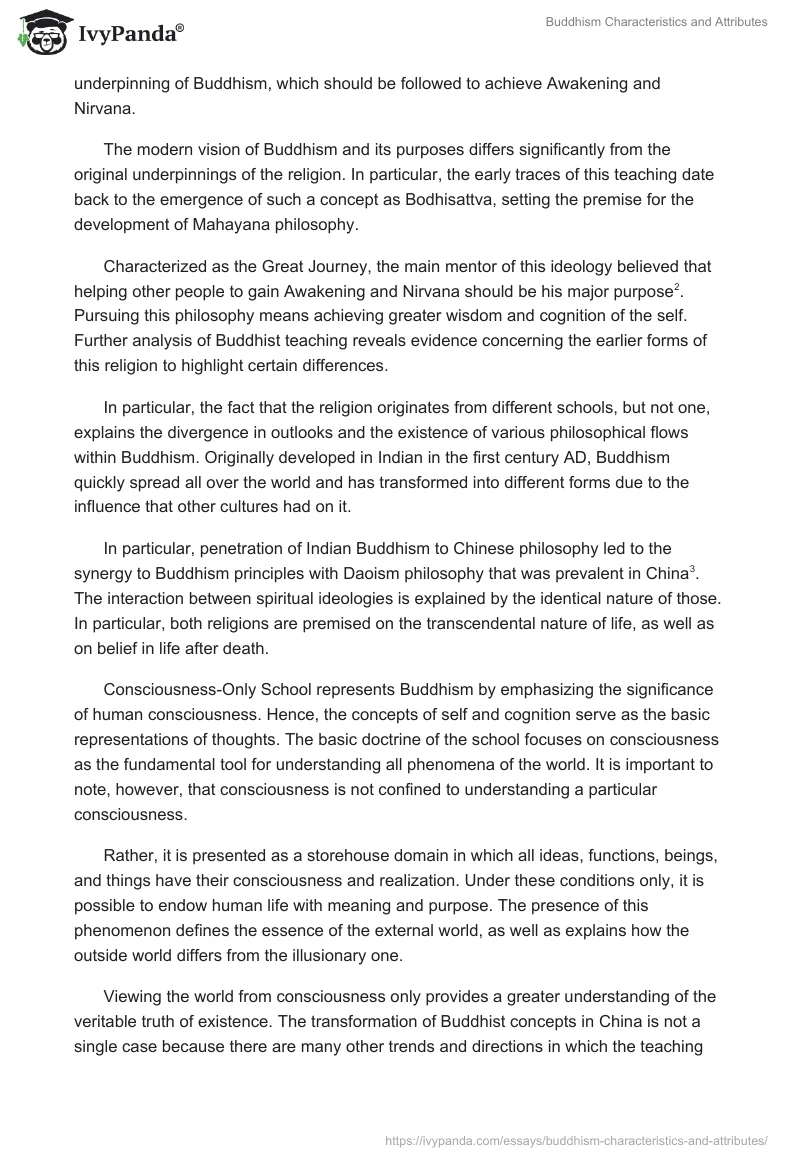Summary
The readings under analysis focus on the main characteristics and attributes of Buddhism, as well as on schools of thought that emerged due to the spread of this teaching. In particular, Mitchell’s book refers to the analysis of origins of Buddhist philosophy, particularly to the concept of Great Vehicle introduced by Mahayana trend.
Causes and influences of Indian Buddhism on Chinese philosophy are also included in the discussion to define which transformations occurred to Chinese belief systems. Thus, both ancient and modern representations of the Indian religion have been presented in the reading to define the essence of Buddhism.
The topic of the reflection paper is the development and origins of Buddhism, as well as its impact on other cultures and religions. This is of particular influence of Mahayana on Chinese culture.
Reflection
Buddhist philosophy premises on three major pillars – impermanence, dissatisfactory spirit, and selflessness – shaping the main attitude of humans to live. At this point, the believers should not pay attention to the actual essence of religion, as well as challenges of secular life. Instead, their faith should be strong enough to be able to look beyond these challenges.
The concept of impermanence focuses on the constant flux and changeability of life, which means that nothing could be eternal in a secular world. Dissatisfactory state refers to human’s constant discontent with his being and his current life. Therefore, it is natural for an individual to strive to be better, wiser, and smarter. Self-development and fulfillment is another important purpose of those people who support Buddhism.
Finally, selflessness implies suffering of human nature because individuals can cognize the truth by overcoming hardships. All these aspects shape the main underpinning of Buddhism, which should be followed to achieve Awakening and Nirvana.
The modern vision of Buddhism and its purposes differs significantly from the original underpinnings of the religion. In particular, the early traces of this teaching date back to the emergence of such a concept as Bodhisattva, setting the premise for the development of Mahayana philosophy.
Characterized as the Great Journey, the main mentor of this ideology believed that helping other people to gain Awakening and Nirvana should be his major purpose. Pursuing this philosophy means achieving greater wisdom and cognition of the self. Further analysis of Buddhist teaching reveals evidence concerning the earlier forms of this religion to highlight certain differences.
In particular, the fact that the religion originates from different schools, but not one, explains the divergence in outlooks and the existence of various philosophical flows within Buddhism. Originally developed in Indian in the first century AD, Buddhism quickly spread all over the world and has transformed into different forms due to the influence that other cultures had on it.
In particular, penetration of Indian Buddhism to Chinese philosophy led to the synergy to Buddhism principles with Daoism philosophy that was prevalent in China. The interaction between spiritual ideologies is explained by the identical nature of those. In particular, both religions are premised on the transcendental nature of life, as well as on belief in life after death.
Consciousness-Only School represents Buddhism by emphasizing the significance of human consciousness. Hence, the concepts of self and cognition serve as the basic representations of thoughts. The basic doctrine of the school focuses on consciousness as the fundamental tool for understanding all phenomena of the world. It is important to note, however, that consciousness is not confined to understanding a particular consciousness.
Rather, it is presented as a storehouse domain in which all ideas, functions, beings, and things have their consciousness and realization. Under these conditions only, it is possible to endow human life with meaning and purpose. The presence of this phenomenon defines the essence of the external world, as well as explains how the outside world differs from the illusionary one.
Viewing the world from consciousness only provides a greater understanding of the veritable truth of existence. The transformation of Buddhist concepts in China is not a single case because there are many other trends and directions in which the teaching has developed. In particular, much information is available about Tathagata who is often identified with Buddha.
Although he has not achieved Nirvana, Tathagata also helped other people to attain Awakening and open their path to Tathagata. Like Buddha, this creature also adhered to the idea that the real world is just one of the destinations at which the human soul should stop because its major purpose is to enter the eternal world of Nirvana.
The stories about Mahasiddhas focus on magic and mysteries accounts about the most influential representatives of the Buddhist teaching. This is of particular concern to Buddhist Tantric. The book also refers to the supernatural powers of people and saints who contributed to the development of the religion. The new interpretation of the teaching has influenced my outlook on Buddhism and its role in the life of people.
In particular, the book focuses on the adventures of magicians who travel across the world and who are engaged in unusual stories. It deviates a bit from a noble representation of purposes that Indian philosophy and, therefore, it provides a new paradigm for perceiving this religion. Finally, the source represents the world in a much broader sense, characterizing the transparent nature of space as well.
In conclusion, Buddhism has developed in new religious frameworks in the course of interaction with cultures and religions. Its original role and concept differ much from the modern outlook on this philosophy. In particular, it was initially developed by lay people, but not by monks.
References
Donald Mitchell. Buddhism: Introducing the Buddhist Experience. (UK: Oxford University Press, 2008).
JeeLoo Liu. An Introduction to Chinese Philosophy: From Ancient Philosophy to Chinese Buddhism. (US: Wiley, 2006), 223.
“On Nature of Buddha.” Web.


